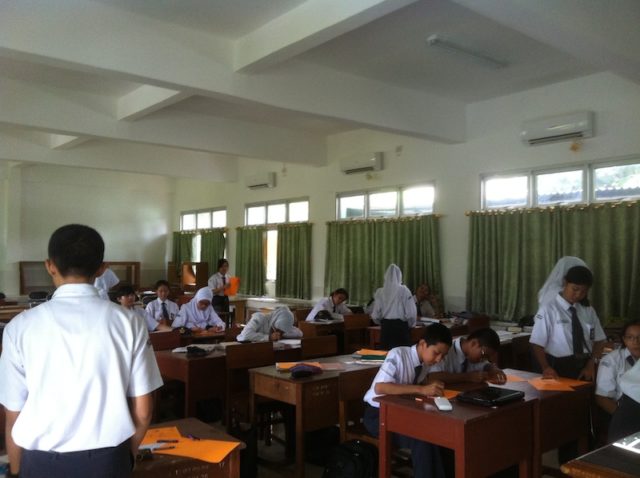Teaching Halloween in Indonesia: A “Spook-tacular” Way to Encourage Cultural Exchange

 It goes like this: I march into each bustling classroom laden with a full bag.
It goes like this: I march into each bustling classroom laden with a full bag.
The students crow the usual Arabic greeting as I plop down at the desk, “Assalaamu ‘Alaikum wa rahmatullahi wa barakatuh.”
I smile and respond with “Good morning.” Someday, I’ll nail the response, “Wa’alaikum Assalaam wa rahmatullahi wa barakatuh,” but it’s not today unfortunately. A moment of silence is then announced for prayers, which is still surprising to me in this public school setting. I went to Catholic school when I was their age, but even I was aware that American public schools tend to be secular. Not so in publicly religious Indonesia.
The students babble as I hook up my laptop to the projector and fall into, if not quite silence, an approximation of it, once I face the classroom.
“Today, we’re talking about Halloween,” I announce, as I remove a plastic sparkly crown from the paper bag, “And I’m a princess.” I place it on my head as my students cheer.

Halloween, which has Celtic roots, is definitely not a thing in Indonesia, despite Indonesians’ strong proclivity for the supernatural. My students grew up on tales of the kuntilanak, a furious female ghost who hungers for human organs, the pocong, the spirit of a corpse still wrapped in the ubiquitous Islamic burial shroud, and other beasties that bump in the night, and many of them, furthermore, believe in their existence. Even many grown Indonesians believe in ghosts. Dunia Lain, a television show which challenges people to stay overnight in haunted places, is littered with possessions on-air.
Even when framed as “cultural exchange,” some more conservative staff and teachers looked aghast upon this “un-Islamic” holiday, with its celebration of demons and witches.
In a real-life example, a friend, driving one night near a hospital with a Dutch student, saw a pocong standing in the road and much to the foreign girl’s disbelief, as she took it for a living person, promptly screamed and hit the accelerator. As the daughter of similarly supernaturally attuned Filipinos, I can’t say I’m an unbeliever — skeptical, yes, but not disinclined towards belief.
But Halloween, despite the mania for American pop culture, is still not commonly understood in Indonesia, and in fact, when a few fellow Fulbright teaching assistants attempted to teach Halloween lessons or throw parties, they ran into problems. Even when framed as “cultural exchange,” some more conservative staff and teachers looked aghast upon this “un-Islamic” holiday, with its celebration of demons and witches.
Of course, this distaste is not dissimilar to some American Christian conservatives’ take on the holiday as inherently Satanic, so that’s not a problem limited only to Islamic countries; it’s heightened here just because Halloween, for all the Indonesian taste for ghosts, is not consistently advertised for a month straight like in America, so in some places in Indonesia, there’s no counter-narrative.
Luckily for me, my first school, an accelerated high school in urban Sumatra, had had many exchange students, so Halloween wasn’t a complete enigma, and they were perfectly happy to accept my proposal for a Halloween lesson as “cultural exchange.” My second school, a middle school, so far, is the same.
I reflect that one of the many things I’m grateful for living in Indonesia is that there’s little of the relentless commercialization of public holidays that bedevil me when I’m stateside.
I run the PowerPoint, explaining Halloween’s origins with the Celts’ Samhain, then moving into contemporary Halloween practices. The students giggle when I show them pictures of myself as a teenager and kid in costume as Mulan, a black widow, and Pinocchio; they ooh when I show them lists of movies and songs, especially at the mention of Michael Jackson, Casper, and Snoopy; they gasp when I tell them Americans spend $6 billion each year on Halloween. As I tell them that many American television channels play only Halloween movies and shows for the entire month of October, I reflect that one of the many things I’m grateful for living in Indonesia is that there’s little of the relentless commercialization of public holidays that bedevil me when I’m stateside.
As I emphasize, again, that none of these traditions, haunted houses, pumpkin-carving, rolling, trick-or-treating, etc., are mandatory, one of my students chimes in, “It doesn’t have to be scary; it can just be fun.”
I nod enthusiastically. “Yes!” I say, relieved that at least some of my students no longer see Halloween as a time of walking dead and crawling fear, a belief that the Celts, coincidentally, similarly held but as a time when fear can be safe, cathartic, even fun.
My favorite part, though, is when I switch to the last slide, which proclaims “Time for candy!” to the cheers of all the students, although it’s contingent that they all say, “Trick or treat!” before I let them rifle through my bag. A small sacrifice for unexpected candy, though some students I gently have to prompt or their impatient peers remind them less gently.
Our last activity is meant to encourage their writing and speaking skills: 1) Draw a picture of a jack o’lantern, name it, and then introduce it to the class or 2) Draw your greatest fear and then explain it to the class.
While I love the interpretations of jack o’lanterns which are often more fanciful than American renderings of jack o’lanterns, as my students have no preconceived notions of what they have to look like, I’m always most interested in the fears.
As I tell them that many American television channels play only Halloween movies and shows for the entire month of October, I reflect that one of the many things I’m grateful for living in Indonesia is that there’s little of the relentless commercialization of public holidays that bedevil me when I’m stateside.
I always share my fears first, drawing them on the board. “I’m scared of bees,” I say, drawing a fat, almost friendly-looking one on the board. I add a frown to make it clear I don’t see them as nice. “I’m afraid of getting stung and dying, because I don’t know if I’m allergic.” I then draw a tall building and a screaming stick figure falling off it. “I’m scared of heights; I’m afraid of falling and breaking all my bones and dying.”
The most common fears, when my students present, by far are of Indonesian ghosts, the pocong, which can only hop due to being so tightly wrapped, and the bloodthirsty kuntilanak; the next are insects, rats, dogs, cats, and other animals. Students frequently refer to horror movies and games, most often Annabelle, the possessed doll from The Conjuring, or popular memes such as Slenderman. Some renderings of iconic horror figures are strangely specific; one favorite was a detailed drawing of a “zombie vampire.”
It’s when we get into unusual, even more abstract territory that it gets interesting. A student said he was scared of the dark, not uncommon, but his drawing was beautiful in its intensity, its atmosphere of doom, as a sea of delicately shaded black and gray. Another feared the sound of wind at night and drew an eerie rendering of it, how it moved things in a room, even getting across how it sighs. One student feared being alone in the dark as well and drew a figure in a fetal position, so clearly terrified that it was heartbreaking.
Teaching Halloween in Indonesia: A “Spook-tacular” Way to Encourage Cultural Exchange.
Other illuminated cultural differences: many students feared Allah, God, which more than anything emphasized to me how deeply ingrained religion is in Indonesian life. Other students feared their parents or disappointing them, which differs, perhaps, from American fears of parental expectations in that Indonesia is a communal, family-oriented society, where respect for parents is deeply embedded in the national psyche.
One student’s fear of Indians (Asian Indians) shocked me, as she cited that she felt they were weird with the “dots on their heads” and turbans; I tried to carefully question her beliefs and their origins in my written comments even as my head reeled. I attempted to remember many of my students, despite their smarts and their media savvy, still hadn’t had much actual contact with non-Indonesians.
Other illuminated cultural differences: many students feared Allah, God, which more than anything emphasized to me how deeply ingrained religion is in Indonesian life.
When all is said and done, though, teaching about Halloween has been my favorite lesson for the past year in Indonesia, not just because it’s a fun, relaxing lesson with candy and artwork for all involved, but because it truly is a time of cultural exchange. I get to teach them about a quintessential American experience that I love, and they get to share the fears and beliefs that are uniquely Indonesian, uniquely themselves, with me. It’s a time when I really do see how culture shapes people and what they believe, and I hope my students get some of the same Aha! experience.
I leave you all with my favorite fear so far this year. A student solemnly stood up and reading from his paper said this:
“I am scared of Thomas the Tank Engine because his face is creepy.”
I never saw it that way, but if you think about it, animate trains are creepy. Stephen King needs to get on that.
Teaching Halloween in Indonesia: A “Spook-tacular” Way to Encourage Cultural Exchange top photo by Unsplash.









One thought on “Teaching Halloween in Indonesia: A “Spook-tacular” Way to Encourage Cultural Exchange”